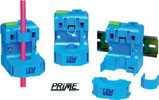

AC measurement is based today mainly on current transformer (CT) technology. These solutions can be limited in applications wrt. high current, high frequency or mechanical fixation.
LEM's PRiME design AP and APR series however, is an alternative to CTs, and is claimed to make current measurement easier and faster in new or existing systems.
Modern manufacturing processes require continuous collection and analysis of operating data in order to provide realtime event, batch and historical information. It is important to measure the electrical currents drawn by the industrial manufacturing systems. Traditionally, magnetic CTs were used for this purpose. However, LEM has developed a product family based on an innovative technology called PRiME (Planar Rogowski I MEasurement) which opens up new opportunities and applications for current measurement.
The AP and APR series has been designed to meet the demands of the new trends in current measurement: higher sensing performance and quick installation. They offer savings in installation time for panel-mount applications by combining split-core functionality and quick connect wiring into a compact, DIN-rail mountable enclosure.
PRiME advantages
The AP and APR series feature user-selectable measuring ranges (from 10 A to 400 A), choice of output options available (4-20 mA or 0-5/0-10 V), and a large sensing aperture with built-in strain relief for the primary conductor.
The PRiME sensing technique where current is sensed without the use of a traditional magnetic circuit is a unique innovation that gives the transducer immunity against saturation due to over-current conditions while maintaining an absolute accuracy of better than 0,8% over a broad range of inputs. This, coupled with a wide, 6 kHz bandwidth, an operating range of -20-60°C, and the availability of a true-RMS model (APR) for non-linear loads or 'noisy' environments, makes the AP and APR transducers an ideal choice for system designers, system integrators and automation distributors looking for accurate and cost-effective DIN-rail mounted AC current transducers.
The PRiME technology solves the inherent limitations of existing CTs caused by their magnetic circuit. A voltage signal is induced into the coil, proportional to the flux derivative and thus proportional to the derivative of the current to be measured.
The unit comprises two parts for the transducer head, a number of sensor PCBs, and a base-PCB. The sensor PCB has two separate air-cored coils and several sensors are mounted at right angles onto the base-PCB. They are connected in series to form two concentric inner and outer loops. To facilitate measurements, the current carrying conductor is positioned within the aperture of the transducer head. This creates an AC magnetic flux, which is coupled into the sensors and induces a voltage proportional to the rate of change of the current (di/dt).
Some key benefits of current transducers based on PRiME: wide dynamic range (typically 1000:1 ratio) capable of withstanding high overload; large bandwidth; lightweight; better accuracy over measuring and temperature range; provides low voltage, isolated output signal (eg, 4-20 mA) which does not require additional safety precautions.
| Tel: | +27 11 626 2023 |
| Email: | [email protected] |
| www: | www.denver-tech.co.za |
| Articles: | More information and articles about Denver Technical Products |

© Technews Publishing (Pty) Ltd | All Rights Reserved